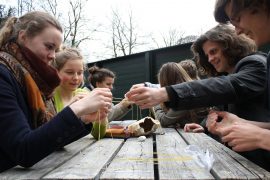In week 4 semester 2 last year, lecturers across the University opened their classroom doors and invited colleagues to sit in and observe how they engage their students. After the event (which is running again this semester – watch this space!), we asked observers what they might try out in their own classrooms. Last year we covered the idea of chunking your class to intersperse activities that helped students better learn material. In this post in the lead-up to semester 1, we explore practical approaches to another idea that many picked up on while observing their colleagues – making lectures ‘authentic’ by bringing in real-world research and examples.
The real world
Make lecture material more relevant with contemporary examples from all areas including media, film and culture.
One observer at an Architecture, Design and Planning lecture highlighted that using contemporary examples from typical outlets that students access could increase relevance and interest. This was picked up by another observer in a Mathematics lecture, who specifically noted that picking up “some current news/events to include as examples” worked well, such as using a regression model to predict Olympic medals. When gearing up for a semester (or anytime, really), you can jot down ideas that you come across in your everyday life that you could vaguely connect to lecture content. Better yet, get your students to do this for you – a Microeconomics lecturer at Macquarie University has his (one and a half thousand) students get onto Twitter and tag photographic examples of oligopolies and competition, amongst other things, using the hashtag #mqecon111 (check it out!). During lectures, he then talks through the Twitter feed, bringing in students’ own found real-world examples. This not only adds authenticity but also allows students to feel like they are contributing to the large class.
Videos are a great way to bring in the real world into lectures. They could be short news clips, an advertisement for a company or product, the latest viral video (that you can twist into an analogy for, or application of, lecture content), a YouTube explanations video (it’s fun to show stylised animations or Khan Academy videos and have students pick holes in it) – the only limit is your creativity. At worst, the video will provide a break for your students. If you use an online source, you don’t even need to fiddle around with embedding videos, just link in the URL of the YouTube, Vimeo, iView, or other video page into your slidedeck, and click it during your presentation. In addition to showing a video, try to wrap an activity around it. It could be as simple as pausing the video halfway and asking students (perhaps via an anonymous student response system) what happens next, or asking students to suggest conceptual errors, or posing further questions from the video. Robyn Johnson from the Faculty of Health Sciences highlighted that this was effective:
Increased use of controversial video – the students participated well with lots of questions, answers, comments and suggestions
Besides social media and video, you could try and bring in other people or locations, either physically or virtually. An observer in a Mathematics lecture noted it was helpful to have “past students as guest speakers in lectures”. They could bring in perspectives from study hints to graduate experiences and destinations. If you can’t bring in an expert physically, it’s a great idea to bring one in virtually. Use Skype, Collaborate, Zoom, or another videoconferencing tool, to connect a lecture class with someone in the field (doesn’t have to be literally in a field). I’ve used Skype and Google Hangouts to connect lectures of 500 students with researchers walking around their molecular biology labs holding a mobile phone – this was a great way for the researcher to introduce their passion and work, and for students to literally see practical applications of the concepts they had been learning in lectures. All it takes is a webcam and microphone (which are already attached to most University lecterns) on your end, videoconferencing software, a smartphone on the other end, and a stable internet connection on either side.
Engaging students with research and enquiry
In a 50-minute (or even 110-minute) lecture, there is limited opportunity to fully engage students in the depth of enquiry needed for research. But this shouldn’t stop us from integrating parts of relevant research into lectures, such as examples that apply or illustrate lecture content. Belinda Norman from the University Library and Dr Luke Hespanhol from the Design Lab both picked up on practical approaches during an Architecture, Design and Planning lecture:
I liked the way the lecturer introduced published research by getting students to answer the survey questions that the research had explored, via a quick discussion. Very clever way to connect students with the material.
Including more practical live exercises/quizzes as part of the lecture, particularly contrasting their results with similar surveys run among the larger population. What I observed was that students in the class tended to be too naive about certain socio-political aspects of the subject…
This is a neat example of piquing student interest in research – by having students engage with part of the research itself. This helps to reduce the mystique of research, showing students how it might connect to what they are learning and perhaps even their lives. Another way to engage students with research is to selectively simplify research papers to make them more accessible to students and allow you to connect lecture content with research papers. Combining contemporary examples with research engagement in large lectures, I’ve pulled apart methods sections from research papers about the cloning and production of erythropoietin and asked students to apply lecture content to figure out steps that molecular biology labs would have taken to identify, clone, and express this protein. The key, at least in this case, was to be very selective about which details to include (to avoid adding unnecessary or unknown complexity) and use a student response system so that students had to apply and check their understanding in class.
Tell me more!
You know your subject matter the best – it’s about connecting this with your students’ world. This will help to enhance their interest and motivation even in large lecture classes.
- Practical strategies for addressing students who lack motivation or interest. A short practical read from Carnegie Mellon University with a few suggested approaches to appeal to students’ interests and intrinsic motivations.
- Approaches that work: How authentic learning is transforming higher education. A short guide from the EDUCAUSE Learning Initiative with real examples of authentic learning. Extends far beyond the lecture but good for inspiration.
- If you have any thoughts or questions about anything mentioned here, please post to the Educational Innovation Yammer group – we’d love to keep the conversation going.
- We’re looking forward to this upcoming week of open doors and seeing what other practical teaching approaches we can pick up from each other. Stay tuned to Teaching@Sydney where we’ll post more details about this semester’s event soon.





